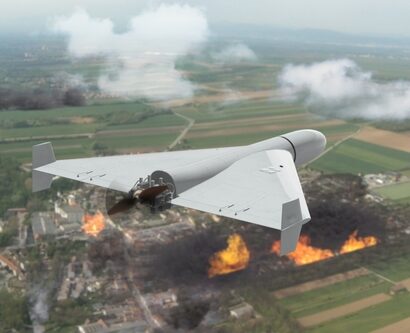Abstract: Ukrainian President Volodymyr Zelenskyy announced the successful test of a domestically developed ballistic missile in the last week of August 2024. This announcement, amidst the ongoing Russia-Ukraine War, underscores the aim to achieve self-reliance and reduce dependence on the Western partners from whom Ukraine must seek permission to strike deep inside Russian territory. Speculations are rife that this missile could be an upgraded version of the Sapsan/Grim-2 missile, which Ukraine has struggled to develop for many years. Without any official technical data or a test video, it is not easy to validate Ukraine’s announcement.
Problem statement: What could be the estimated ranges and initial launch parameters of the Ukrainian-tested projectile to achieve its target/mission objectives?
So what?: Ukraine’s quest to develop effective ballistic missiles stems from its desire to reduce its dependence on the West. However, Ukraine lacks the funding, technical prowess, and industrial complexes to develop ballistic missiles at pace and manufacture them in large numbers. Thus, the objective to domestically manufacture ballistic missiles is still a work in progress, and Ukraine won’t be able to shift away from its Western partners for long-range strike weapons soon.
Source: shutterstock.com/katatonia82A Claim without Evidence
On August 27, 2024, Ukrainian President Vladimir Zelensky declared during a press conference that Ukraine tested its first ballistic missile positively without providing any specific details.[1] Nations aspiring to manufacture ballistic missiles usually make such announcements and provide relevant information like test videos and data. However, Ukraine’s announcement has been shrouded in secrecy. This could be due to various reasons. This test could be a complete failure, which is quite common among ballistic missile developing nations, more so as Ukraine hasn’t released any data on this test since more than one month has passed. Next, this missile could have been supplied from the West and not at all a completely Ukrainian domestic missile. Lastly, Ukrainians could be assuming that keeping this test a secret would keep the Russians guessing about the capabilities of this missile. In the current Russia-Ukraine conflict, this kind of secret missile test will hardly change anything on the ground because this was not a full user trial. Countries developing ballistic missiles test them several times for many years, validating the data and improving on their performance parameters before they finally get operationalised and handed over to the end user. As far as the deterrence value of this test is concerned, deterrence works only when the adversary is aware of the capabilities of the weapons, and since Ukraine has decided to keep this test a secret, it will hardly deter Russia. This has led to various speculations regarding the validity of this ballistic missile test.
On August 27, 2024, Ukrainian President Vladimir Zelensky declared during a press conference that Ukraine tested its first ballistic missile positively without providing any specific details.
Why the Domestic Test?
Ukraine likely felt the need to manufacture domestic ballistic missiles mid-war with Russia for various reasons. Although Ukraine has received long-range weapons from the West, like the U.S. Army Tactical Missile Systems (ATACMS), British Storm Shadows, and French SCALP/T, it lacks permission to strike targets deep inside Russia.[2] Having a domestic ballistic missile gives Ukraine the option to strike where it chooses. Furthermore, experts have noted that the combination of cruise and ballistic missiles can put pressure on Russian air defence systems.[3] Further ballistic missiles can also carry Multiple Independently Targetable Re-entry Vehicles (MIRVs), which can help deliver multiple warheads at different targets with a single missile and help deceive air defence systems.
Although Ukraine has received long-range weapons from the West, like the U.S. ATACMS, British Storm Shadows, and French SCALP/T, it lacks permission to strike targets deep inside Russia.
If Ukraine starts domestically producing missiles, this can impact the missile-exporting corporations which have thrived in the Russia-Ukraine war. This can further push Ukraine’s Western partners to overcome their fears of escalation, and allow Ukraine to strike deep targets.[4] Utility and effectiveness can definitely be a factor as ballistic missiles can burrow deep with greater force into hardened targets and reinforced structures above ground.[5] Also, as President Zelenskyy said, this test can serve as a confidence booster for Ukrainian society and assure them that their domestic defence producers are working 24/7.[6]
Speculations about the Domestic Missile
After President Zelenskyy’s announcement, speculations regarding missile type, capabilities, range, and variant are gaining momentum. A defence portal editor points out that Ukraine has several domestic missile programs, including the Sapsan and its export version Hrim-2/Thunder-2/Grim-2, which was first unveiled in 2018. Previously, the head of the Main Directorate of Missiles, Artillery, and Unmanned Systems of the General Staff of the Armed Forces of Ukraine has claimed that a domestically designed missile derived from Sapsan/Hrim-2 has hit a target at a distance of 700 kilometres (km) during tests. In March 2023, the Russian Defence Ministry claimed to have intercepted Hrim-2 missiles near Novoandriyivka and Zeleny Hay, indicating their operational status.[7] However, this claim was quickly corrected by the Russian Defence Ministry, as the images of the missile wreckage proved otherwise.[8]
Those who assert that the test mentioned by Zelensky is likely of an operational-tactical system of Sapsan missile believe that this was the only project in which Ukraine invested a long time and was in the final stages of completion. It would likely be futile to speculate on any other missile as Ukraine is bound by the Intermediate-Range Nuclear Forces (INF) Treaty regulations, which prohibit the development of missiles in ranges of 500-5500 km. This implies that the maximum predictable range of Sapsan/Hrim-2 could be 500 km and the minimum range at 280 km.[9] Other military experts believe that the missile tested is unrelated to Hrim-2 and could actually be a Short-Range Ballistic Missile (SRBM) with a range under 300 km.[10] In 2023, the then Ukrainian Minister of Defence Oleksii Reznikov, hinted that Ukraine is possibly developing a missile with a 1000 km range.[11] As per the author’s assessment from the above reports, the likely probable maximum missile ranges of this secret missile could be 500 km, 700 km and 1000 km.
It would likely be futile to speculate on any other missile as Ukraine is bound by the INF Treaty regulations, which prohibit the development of missiles in ranges of 500-5500 km.
The Sapsan/Hrim-2 has a minimum range of 280 km.[12] Some reports have suggested that it can destroy an area of 10,000 square meters.[13] Pivdenne/Yuzhnoye Design Bureau claimed that they can fly in ballistic as well as aeroballistic trajectories.[14] Their design is reported to be similar to the Russian Iskander-M, which has a length of 7.2 meters and carries a 500 kg warhead. Sapsan and Hrim-2 have diameters of 0.9 and 0.6 metres, respectively. The Iskander has an average speed of 1389 m/s and a terminal speed of 2100 m/s.[15] Currently, the speed of the tested missile is unknown.
Possibility of Western Assistance?
The day this missile was tested, the Russian Foreign Ministry’s special envoy, Rodion Miroshnik, said that Ukraine could not produce a ballistic missile of its own. He noted that the Yuzhnoye Design Bureau never had a full cycle of developing such a missile as the control systems are procured from outside. They can assemble the components. He asserts that Ukraine can’t pursue such developments without its Western partners.[16]
As per the Nuclear Threat Initiative, Ukraine is capable of manufacturing advanced ICBMs, and its missile industry is second only to Russia among former Soviet states. The economic crisis in the 90s affected the design and production infrastructure and triggered a technical staff loss. These led Ukraine to embark on joint projects with Western nations. Ukraine has also sought investments from Japan for its missile industry, but Russia still plays a central role in Ukrainian rocket projects. The Ukrainian missile components industry is neither self-contained nor self-sufficient.[17]
The Ukrainian missile components industry is neither self-contained nor self-sufficient.
In December 2022, Dr. Oleksandr Marchenko, a physicist involved in Ukraine’s missile development, said that Ukraine possessed certain expertise to develop intercontinental ballistic missiles (ICBMs), and work was underway in the Soviet-era Pivdenmash factory.[18] The Sapsan/Grim-2 system was officially introduced in 2013. However, funding and investment issues led to a delay in the completion of the project.[19] In August 2024, the Ukrainian government announced that it would allocate additional funding for its domestic missile program.[20] Here, Western assistance in the form of investments can’t be ruled out. However, in terms of technology, it is difficult to assess accurately.
Open-Source Information
In September 2023, President Zelensky posted on Telegram that a Ukrainian missile had successfully hit a target 700 km away. The Secretary of Ukraine’s National Security and Defence Council, Oleksiy Danilov, said that the missile could travel further but didn’t specify other details like the full range, time of firing, and target details. Later, he also tweeted a video quoting, “the missile programme of the President of Ukraine in action. The tests are successful; the implementation is effective. Sevastopol is waiting, Kamchatka is waiting, Kronshtadt is waiting.”[21] The tweet containing the video is perhaps the only open-source information as of now to decode about the mystery missile tested by Ukraine in late August 2024. The 20-second video tweeted by Oleksiy Danilov in August 2023 was taken at night with zero visibility. The missile design and dimensions can’t be validated. The launch countdown is heard in Russian/Ukrainian, and the projectile is fired approximately at the 13th second and has a slant angle of approximately 40-50 degrees.[22]
This short video clip provides basic information. At the 14th second, there is a slight visibility of the projectile being fired from a static platform, which could be a transporter-erector-launcher (TEL). The acute firing angle suggests that this projectile was intended to cover short ranges, unlike a ballistic missile that covers a longer range and is fired vertically at higher angles. Unlike a ballistic missile launch, in which the missile lifts at a slower initial velocity, this projectile had a high initial velocity, suggesting it was more of a rocket or an artillery system. Finally, the amount of fire and smoke generated after firing points towards a lower fuel consumption, which again implies the system is far from being a ballistic missile that carries multiple burn stages and produces more smoke and fire.
Estimated Flight Path Assessment
The preliminary information helps to estimate the maximum final velocity, total flight time, maximum height and total range of the projectile. Pivdenne/Yuzhnoye Design Bureau claims that Sapsan/Hrim-2 can fly both in ballistic and aero-ballistic (missile under free fall condition dropped from a height) mode. In ballistic mode, the flight path assessment is estimated arbitrarily for launch angle ranges between 40-50 degrees, as observed in the tweeted video using a projectile motion calculator.[23] At 0 degrees in aero-ballistic mode, a horizontal projectile motion calculator is used.[24] A general Soviet-style TEL used by Ukraine is similar to the Russian Iskander TEL’s height, which is around 3 meters.[25] An average initial velocity of 1389 m/s, similar to the Iskander missile, is assumed.


An upgraded version of the Sapsan/Grim-2 missile in ballistic trajectory would need at least a minimum velocity of 2215 m/s, 2800 m/s & 3180 m/s to reach ranges of 500 km, 700 km and 1000 km, respectively. In an aero-ballistic mode, when the missile is dropped from a fighter jet or bomber, a minimum velocity of 1389 m/s is required at heights of 636 km, 1246 km and 2546 km to reach targets at 500 km, 700 km and 1000 km, respectively. Although rocket motors power the Sapsan/Grim-2, it is difficult to estimate whether the tested missile can acquire such initial velocities and ranges, respectively, without additional motor stages or a more powerful rocket booster motor.
Challenges and Way Ahead
Ukrainian leadership believe that ballistic missiles can help in destroying the logistic routes used by Russia to transport ammunition, weapons, and the army. It can also help target the Russian depots now situated at a faraway distance of more than 300 km. Ukraine particularly wants to target airfields and aircraft located in Krasnodar Krai, Yeysk, Crimea, and the Kerch Bridge. Ukraine also desires to attack Russian defence industries, which are situated farther away at 1500 km. Moreover, there are technical challenges for effective targeting due to a lack of powerful rocket boosters, a lack of guidance and accurate reconnaissance, Russian air defence, and a lack of EW assets. There is no concrete plan for several missiles to be produced due to financial constraints. Although Ukraine desires joint production with its Western partners, that option is not feasible soon as the West’s ammunition stocks have dwindled over the past two years.[26]
Ukraine particularly wants to target airfields and aircraft located in Krasnodar Krai, Yeysk, Crimea, and the Kerch Bridge.
Going ahead, it can be predicted that the indigenous ballistic missile test of Ukraine will hardly have any impact on the current battlefield as Russia not only has a steady supply of missiles from North Korea and Iran but is also dominant in manufacturing its own missiles. Apart from the technical challenges, the notion of deterring and targeting long-distance targets inside Russia with ICBMs is a dangerous proposition. For Ukraine, increasing the range only till its area of interest (area to be liberated), is a logical lesson but is currently not feasible. In the meantime, the process of supplying long-range systems from the West to Ukraine is here to stay, irrespective of Ukraine’s ability to test/produce its missiles.
Ajay Kumar Das is pursuing an MA in International Relations, Security & Strategy from Jindal School of International Affairs (JSIA), Jindal Global University (JGU), Haryana, India. His areas of interest are National Security, Air-Power, Maritime Security, and Geopolitics. He has published articles in the Forum for Integrated National Security, Forum for Global Studies, The Diplomatist, and the Centre for Joint Warfare Studies. The views contained in this article are the author’s alone and do not represent the views of JGU.
[1] “Zelensky Claims Ukraine Has Tested Its First Ballistic Missile,” TASS, August 27, 2024, https://tass.com/world/1834613.
[2] Martin Fornusek, “Ukraine Tests Its First Ballistic Missile, Zelensky Says,” The Kyiv Independent, August 27, 2024, https://kyivindependent.com/ukraine-tests-its-first-ballistic-missile-zelensky-says/.
[3] Michel Martin, “Ukraine Has Successfully Tested Ballistic Missiles That Were Made in Ukraine,” NPR, August 28, 2024, https://www.npr.org/2024/08/28/nx-s1-5090919/ukraine-has-successfully-tested-ballistic-missiles-that-were-made-in-ukraine.
[4] Alya Shandra, “Ukraine’s Ballistic Missile Breakthrough Can Alter War Dynamics,” Euromaidan Press, August 29, 2024, https://euromaidanpress.com/2024/08/29/500km-game-changer-ukraines-ballistic-missile-breakthrough-can-alter-war-dynamics/.
[5] Joseph Trevithick, “Ukraine Says It Has Tested a New Domestically-Designed Ballistic Missile,” The War Zone, August 27, 2024, https://www.twz.com/air/ukraine-says-it-has-tested-a-new-domestically-designed-ballistic-missile.
[6] Veronika Melkozerova, “Ukraine Successfully Tests Its First Ballistic Missile,” Politico, August 27, 2024, https://www.politico.eu/article/ukraine-russia-invasion-first-ballistic-missile-volodymyr-zelenskyy-military-production/.
[7] Bartlomiez Wypartowicz, “Ukraine Tests Hrim-2 – Its First Indigenous Ballistic Missile,” Defence24.com, August 28, 2024, https://defence24.com/industry/ukraine-tests-hrim-2-its-first-indigenous-ballistic-missile.
[8] Joseph Trevithick, “Ukraine Says It Has Tested a New Domestically-Designed Ballistic Missile,” The War Zone, August 27, 2024, https://www.twz.com/air/ukraine-says-it-has-tested-a-new-domestically-designed-ballistic-missile.
[9] Alya Shandra, “Ukraine’s Ballistic Missile Breakthrough Can Alter War Dynamics,” Euromaidan Press, August 29, 2024, https://euromaidanpress.com/2024/08/29/500km-game-changer-ukraines-ballistic-missile-breakthrough-can-alter-war-dynamics/.
[10] Joseph Trevithick, “Ukraine Says It Has Tested a New Domestically-Designed Ballistic Missile,” The War Zone, August 27, 2024, https://www.twz.com/air/ukraine-says-it-has-tested-a-new-domestically-designed-ballistic-missile.
[11] “Ukraine Develops Its Own Long-Range Missile,” Militarnyi, June 08, 2023, https://mil.in.ua/en/news/ukraine-develops-its-own-long-range-missile/.
[12] “Ukraine Successfully Tests Its First Ballistic Missile as Zelensky Urges Use of Long-Range Arms,” Armyrecognition.com, August 27, 2024, https://armyrecognition.com/news/army-news/army-news-2024/ukraine-successfully-tests-its-first-ballistic-missile-as-zelensky-urges-use-of-long-range-arms.
[13] Alexander Begej, “Ukraine Set to Go Ballistic,” Georgetown Security Studies Review, March 07, 2018, https://georgetownsecuritystudiesreview.org/2018/03/07/ukraine-set-to-go-ballistic/.
[14] Anton Mikhnenko, “Ukraine Expands Its Missile Capabilities,” Jamestown.org, April 16, 2019, https://jamestown.org/program/ukraine-expands-its-missile-capabilities/.
[15] Alya Shandra, “Ukraine’s Ballistic Missile Breakthrough Can Alter War Dynamics,” Euromaidan Press, August 29, 2024, https://euromaidanpress.com/2024/08/29/500km-game-changer-ukraines-ballistic-missile-breakthrough-can-alter-war-dynamics/.
[16] “Zelensky Says Ukraine Tests Its Own Ballistic Missile,” TASS, August 28, 2024, https://tass.com/world/1835021.
[17] “Ukraine Missile Overview,” The Nuclear Threat Initiative, January 28, 2015, https://www.nti.org/analysis/articles/ukraine-missile/.
[18] “Ukraine Test Fired Domestically-Produced Ballistic Missiles, Says Zelensky,” Kyiv Post, August 27, 2024, https://www.kyivpost.com/post/38043.
[19] iHLS News Desk, “Ukraine Successfully Launches First Self-Produced Ballistic Missile,” iHLS, September 02, 2024, https://i-hls.com/archives/125367.
[20] “Zelensky️: Ukraine Successfully Tests First Ballistic Missile,” Militarnyi, August 27, 2024, https://mil.in.ua/en/news/zelensky-ukraine-successfully-tests-first-ballistic-missile/.
[21] David L.Stern and Serhiy Morgunov, “Ukraine Says It Has Manufactured and Fired a Long-Range Missile,” Washington Post, September 01, 2023, https://www.washingtonpost.com/world/2023/09/01/ukraine-missile-longrange-russia-manufactured/.
[22] Oleksiy Danilov, X (formerly Twitter), August 31, 2023, https://x.com/OleksiyDanilov/status/1697229639289012692.
[23] Bogna Szyk and Hanna Pamuła. “Projectile Motion Calculator,” Omnicalculator.com, July 30, 2024, https://www.omnicalculator.com/physics/projectile-motion.
[24] Hanna Pamula, “Horizontal Projectile Motion Calculator,” www.omnicalculator.com, April 19, 2024, https://www.omnicalculator.com/physics/horizontal-projectile-motion.
[25] “9P78 TEL for the 9K720 Iskander Complex,” Truck-encyclopedia.com, n.d, https://truck-encyclopedia.com/modern/russia/9K720-iskander.php.
[26] Alya Shandra, “Ukraine’s Ballistic Missile Breakthrough Can Alter War Dynamics,” Euromaidan Press, August 29, 2024, https://euromaidanpress.com/2024/08/29/500km-game-changer-ukraines-ballistic-missile-breakthrough-can-alter-war-dynamics/.




